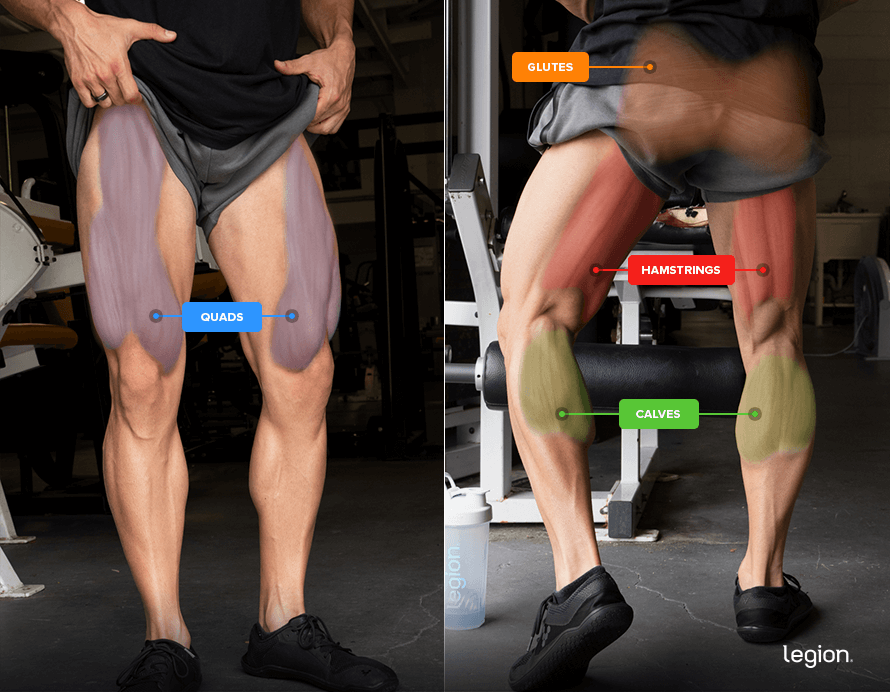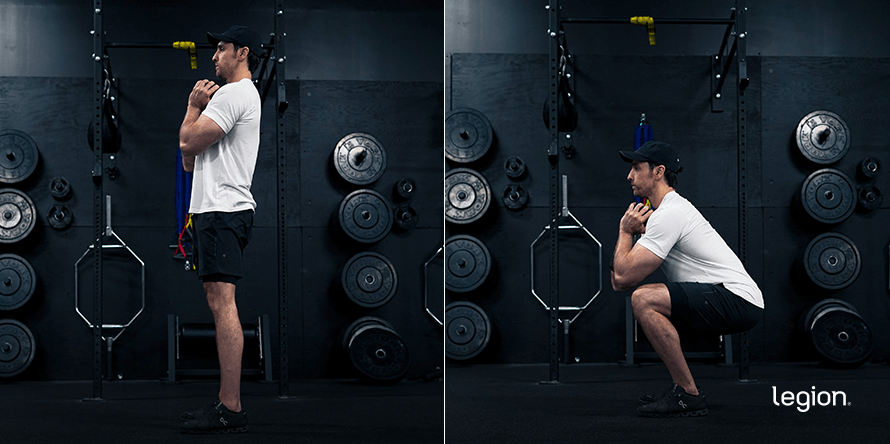Read more at:
The goblet squat doesn’t get the recognition it deserves.
While it may not allow you to lift as heavy as other squat variations, it’s a highly effective leg exercise with unique benefits.
For example, it’s perfect for beginners because it’s straightforward to learn and allows you to start light and progress slowly. It’s also an excellent squat variation for people with a history of injuries since it’s gentler on your joints than most other types of squat.
In this article, you’ll learn what the dumbbell goblet squat is, its benefits, which muscles it works, how to do it with proper form, the best goblet squat alternatives, and more.
What Is A Goblet Squat?
The goblet squat is a lower-body exercise that involves squatting while holding a dumbbell vertically in front of your chest, almost like you’re holding a goblet (hence the name).
You can use other types of resistance to perform the goblet squat, including a kettlebell or resistance band. However, since most people prefer using a dumbbell, the dumbbell goblet squat (or “DB goblet squat”) is the variation we’ll focus on in this article.
Goblet Squat vs. Regular Squat: Which Is Better?
It depends.
The main benefits of the goblet squat are that it’s easy to learn, allows you to train with light weights, requires minimal equipment, and is gentler on your joints than most other squatting exercises.
As such, the goblet squat is ideal for new weightlifters, those without access to gym equipment (people who train at home or while traveling, for example), and people who are training around an injury.
That said, the traditional squat allows you to train more muscles across your body with heavier weights and progress more regularly and in larger increments, which means it’s superior for building muscle and strength.
Of course, there’s no reason to include just one of these squat movements in your program. The best solution for most people is to do both.
A sensible way to do this is to start your leg workout with the barbell squat, then perform the goblet squat later in your workout when supporting muscles like your lower back are bushed, but your legs can probably manage another few sets.
This is how I personally like to organize my training, and it’s similar to the method I advocate in my fitness books for men and women, Bigger Leaner Stronger and Thinner Leaner Stronger.
(And if you’d like even more specific advice about what exercises to include in your training program to reach your health and fitness goals, take the Legion Strength Training Quiz, and in less than a minute, you’ll know the perfect strength training program for you. Click here to check it out.)
Goblet Squat: Benefits
1. It trains several major muscle groups.
Most people think of the goblet squat as a leg exercise.
While it’s true that the main muscles worked by the goblet squat are the quads, hamstrings, glutes, and calves, it also trains several muscle groups across your entire body, including the biceps, chest, shoulders, and abs.
2. It’s easier on your knees and back.
Research shows that squat variations that place the load on the front of your body, such as the goblet squat, place significantly less stress on your knees and back than squat variations that place the load on the back of your body.
This makes the goblet squat an excellent variation for those with knee or back issues.
3. It’s easy to learn.
Most folks consider the barbell back squat the king of squat exercises.
However, although the barbell back squat is an excellent lower-body exercise, it’s not always the ideal starting point for new weightlifters. That’s because it requires a degree of balance, coordination, flexibility, and strength that not all beginners possess.
The goblet squat is a good workaround if you struggle with the barbell back squat because it allows you to train the same muscles as the back squat but with lighter weights. This makes the goblet squat a simple way to practice proper form while building your strength over time.
Goblet Squat: Muscles Worked
The goblet squat works the . . .
- Quadriceps
- Hamstrings
- Glutes
- Calves
It also trains your pecs, biceps, and shoulders to a lesser degree.
Here’s how those muscles look on your body:

Goblet Squat: Form
The best way to learn how to do a goblet squat is to split the exercise into three parts: set up, descend, and squat.

1. Set up
Stand with your feet a little wider than shoulder-width apart and your toes turned slightly out. Grip a dumbbell by one end, holding the weight vertically at chest height with your elbows tucked close to your sides.
2. Descend
Take a deep breath into your stomach, push your chest out, brace your abs, and sit down by pushing your hips backward and bending your knees at the same time.
As you descend, push your knees out in the same direction as your toes.
Keep sitting down as far as you comfortably can, ideally until your thighs are parallel to the floor or slightly lower.
3. Squat
Stand up and return to your starting position. This mirrors what you did during the descent.
Don’t let your chest fall forward or rock onto your tippy-toes—this wastes energy and makes standing up trickier.
A good cue to counter this is to think about “pushing off your heels.” This helps keep the weight centered over your midfoot throughout the squat.
Goblet Squat: Common Mistakes
1. Holding the weight away from your body.
Holding the weight away from your body forces your biceps, forearms, and shoulders to bear weight, which makes balancing more challenging and limits the amount of weight you can lift.
To correct this, hold the weight close to your chest with your elbows fully bent.
2. Leaning or tipping forward.
As you fatigue during a set, it’s common to allow your elbows to drop toward your sides. This can throw off your balance, and make performing the exercise with proper form difficult.
To fix this mistake, focus on driving your elbows forward, under the weight. If maintaining this position for a full set proves challenging, consider reducing the weight or work on building upper-back strength.
3. Allowing your knees to cave inward.
To prevent your knee caving inward as you squat, think about spreading the floor apart with your feet by driving your feet into the ground and away from each other (though they shouldn’t actually move).
This keeps your knees tracking in line with your toes (which is safer), increases the activation of your glutes, and enables you to lift more weight with a lower risk of pain or injury.
The Best Goblet Squat Alternatives
1. Heel-Elevated Goblet Squat
In the heel-elevated goblet squat, you elevate your heels 1-to-2 inches off the floor using a sturdy object like a weight plate, step, or squat wedge. Elevating your heels enables you to squat deeper, regardless of your ankle mobility, making the heels-elevated goblet squat a good option for those with limited lower-body flexibility.
Performing the goblet squat with elevated heels also demands more from your quads, making the heel-elevated goblet squat an excellent goblet squat variation for those seeking to maximize their quad development.
2. Kettlebell Goblet Squat
The kettlebell goblet squat (or “KB goblet squat”) is almost identical to the dumbbell goblet squat. The only difference is you hold a kettlebell by the “horns” (the vertical parts of a kettlebell handle) at chest height instead of a dumbbell.
As such, you can think of the kettlebell and dumbbell goblet squats as interchangeable—do whichever you have equipment for.
3. Sumo Goblet Squat
Many people think the sumo goblet squat is the best goblet squat for glutes because research shows squatting with a wider stance increases glute activation. Taking a wider stance also allows you to squat deeper, which tends to be better for training your glutes.
+ Scientific References
- Collins, Kyle S., et al. “Differences in Muscle Activity and Kinetics between the Goblet Squat and Landmine Squat in Men and Women.” Journal of Strength and Conditioning Research, vol. Publish Ahead of Print, 2 Aug. 2021, https://doi.org/10.1519/jsc.0000000000004094.
- Gullett, Jonathan C, et al. “A Biomechanical Comparison of Back and Front Squats in Healthy Trained Individuals.” Journal of Strength and Conditioning Research, vol. 23, no. 1, Jan. 2009, pp. 284–292, journals.lww.com/nsca-jscr/fulltext/2009/01000/A_Biomechanical_Comparison_of_Back_and_Front.41.aspx, https://doi.org/10.1519/jsc.0b013e31818546bb.
- Paoli, Antonio, et al. “The Effect of Stance Width on the Electromyographical Activity of Eight Superficial Thigh Muscles during Back Squat with Different Bar Loads.” Journal of Strength and Conditioning Research, vol. 23, no. 1, Jan. 2009, pp. 246–250, https://doi.org/10.1519/jsc.0b013e3181876811. Accessed 7 May 2019.
- Larsen, Stian , et al. Effects of Stance Width and Barbell Placement on Kinematics, Kinetics, and Myoelectric Activity in Back Squats. Jan. 9AD, www.frontiersin.org/articles/10.3389/fspor.2021.719013/full, https://doi.org/10.3389/fspor.2021.719013. Accessed 1 Sept. 2021.
- Lorenzetti, Silvio, et al. “How to Squat? Effects of Various Stance Widths, Foot Placement Angles and Level of Experience on Knee, Hip and Trunk Motion and Loading.” BMC Sports Science, Medicine and Rehabilitation, vol. 10, no. 1, 17 July 2018, bmcsportsscimedrehabil.biomedcentral.com/articles/10.1186/s13102-018-0103-7, https://doi.org/10.1186/s13102-018-0103-7.
- Contreras, Bret, et al. “A Comparison of Gluteus Maximus, Biceps Femoris, and Vastus Lateralis Electromyography Amplitude in the Parallel, Full, and Front Squat Variations in Resistance-Trained Females.” Journal of Applied Biomechanics, vol. 32, no. 1, 2016, pp. 16–22, www.ncbi.nlm.nih.gov/pubmed/26252837, https://doi.org/10.1123/jab.2015-0113.
- Kubo, Keitaro, et al. “Effects of Squat Training with Different Depths on Lower Limb Muscle Volumes.” European Journal of Applied Physiology, 22 June 2019, https://doi.org/10.1007/s00421-019-04181-y.
- Marchetti, Paulo Henrique, et al. “Muscle Activation Differs between Three Different Knee Joint-Angle Positions during a Maximal Isometric Back Squat Exercise.” Journal of Sports Medicine, vol. 2016, 2016, pp. 1–6, www.ncbi.nlm.nih.gov/pmc/articles/PMC4967668/, https://doi.org/10.1155/2016/3846123. Accessed 9 Dec. 2019.
